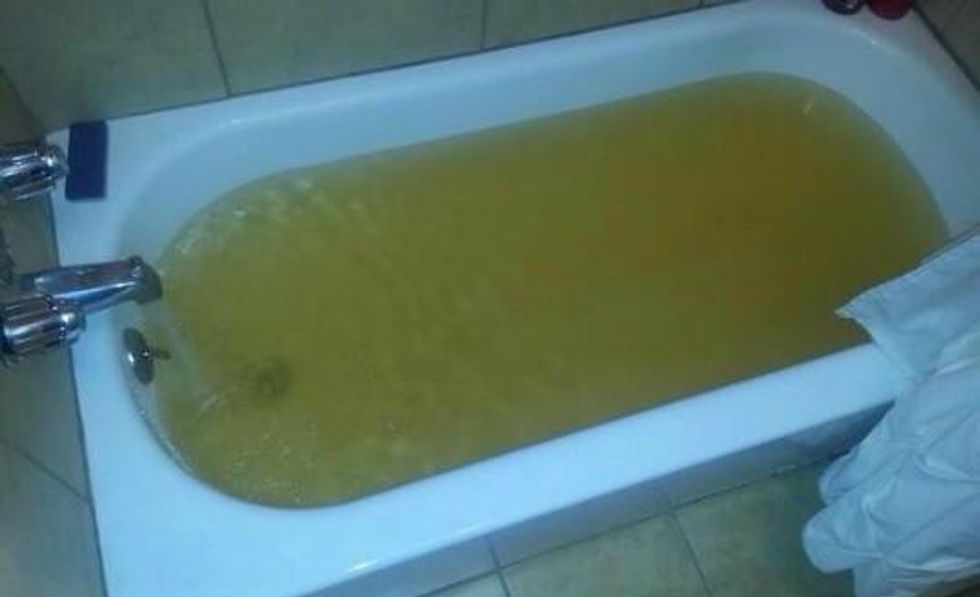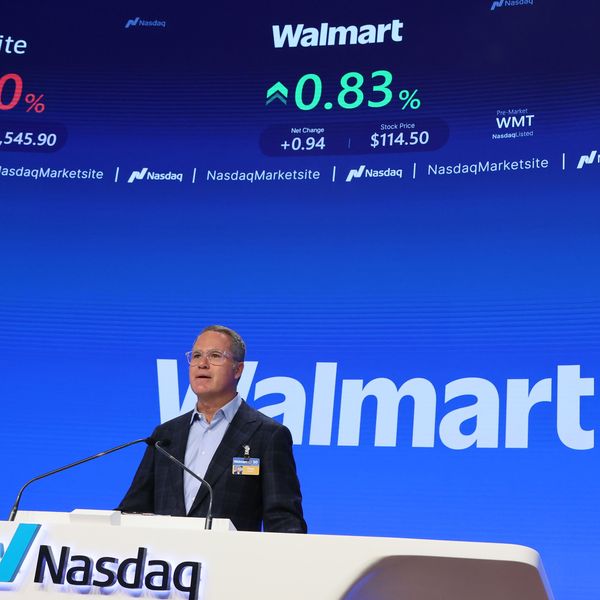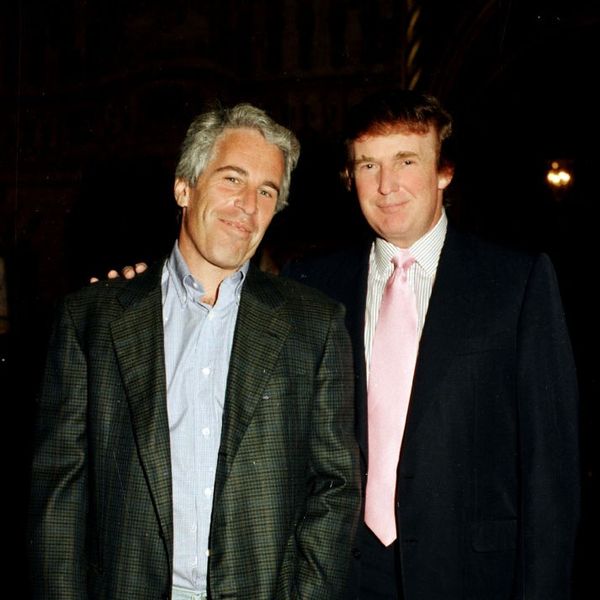Poorest at Risk, Skepticism High as Officials OK Water Safety in West Virginia
Though officials announce water back at 'safe' limit, scientists and vulnerable residents not so sure

"My mom's a nurse, and she didn't want us drinking it or giving it to the kids or our animals," Shawna Moore, a mother of two, told the New York Times.
On Tuesday, West Virginia American Water (WVAW), the regional utility, continued its second day of lifting the drinking ban throughout Charleston and the surrounding area--four days after the toxic detergent 4-methylcyclohexane methanol (or MCHM) spilled into the Elk River, contaminating the local water supply.
The Times notes that despite city officials giving the greenlight, the announcement has been met with widespread public distrust, with the majority of local residents interviewed saying they would continue to drink and cook with bottled water.
While some areas have received ample support to prolong continued bottle water use, reporting by Al Jazeera shows that regional economics affect how quickly others must return to the tap.
In the coal mining town of Nellis, an hour south of Charleston, residents describe inflated pricing and fights breaking out over scarce supplies. Al Jazeera reports:
Jessica Hempstead, 22, who makes $9 an hour, encountered chaos at a big-box store the first night of the water ban. People were grabbing bottles off the shelves even though the store had almost doubled the price of packaged water.
"You had to literally fight people to get it," she said. "We paid $4 for one case that's usually about $2. We paid $3 for one case that's usually about a dollar. Usually $2.97 was $4.36."
"If you are living paycheck to paycheck, purchasing bottled water or driving to the nearest distribution point for a rationed amount of water, it can quickly drain your wallet," Vivian Stockman, an activist with the Ohio Valley Environmental Coalition, told Al Jazeera.
"People with more money, they can go buy water all they want to, and here we are having to carry it half a mile, and go up to the spring and carry it with jugs," Hempstead continues. "You take it for granted when you have it every day. We had to turn our main line off, because it was coming up from the toilets, and it took your breath away. Your skin itches, your eyes burn."
Last Thursday, 7,500 gallons of MCHM spilled from coal processing plant Freedom Industries into the Elk River, a mile and a half upstream from the intake pipes for WVAW, which serves nine counties.
During a press conference Monday, state officials and executives from the West Virginia American Water utility company announced that the presence of MCHM in the water supply had reached a "safe" level of one part per million (1 ppm).
However, because such little data exists on MCHM, particularly its effects on human health, scientists are questioning the method used to derive these safe limits.
Richard Denison, senior scientist with the Environmental Defense Fund, said the government calculation of 1ppm appeared to be based on a single study by the chemical's manufacturer, never published, and that it included several "significant leaps in their calculation of a 'safe' exposure level."
Further, Denison notes that the officials' calculations "utterly fail to account for chronic health effects from longer-term exposure to water contaminated at the 1 ppm level."
"Based on what we do know, there are good reasons to believe that officials are overlooking significant health risks," he added.
After the ban was lifted, residents were quick to post photos of the allegedly "safe" water online.
\u201cLook at my water 45 mins into the flush!!!!!@erinbrochovich @wsaztv #wvwatercrisis #wvchemleak\u201d— MelindaStarcherWVRealtor (@MelindaStarcherWVRealtor) 1389790556
_____________________
An Urgent Message From Our Co-Founder
Dear Common Dreams reader, The U.S. is on a fast track to authoritarianism like nothing I've ever seen. Meanwhile, corporate news outlets are utterly capitulating to Trump, twisting their coverage to avoid drawing his ire while lining up to stuff cash in his pockets. That's why I believe that Common Dreams is doing the best and most consequential reporting that we've ever done. Our small but mighty team is a progressive reporting powerhouse, covering the news every day that the corporate media never will. Our mission has always been simple: To inform. To inspire. And to ignite change for the common good. Now here's the key piece that I want all our readers to understand: None of this would be possible without your financial support. That's not just some fundraising cliche. It's the absolute and literal truth. We don't accept corporate advertising and never will. We don't have a paywall because we don't think people should be blocked from critical news based on their ability to pay. Everything we do is funded by the donations of readers like you. Will you donate now to help power the nonprofit, independent reporting of Common Dreams? Thank you for being a vital member of our community. Together, we can keep independent journalism alive when it’s needed most. - Craig Brown, Co-founder |

"My mom's a nurse, and she didn't want us drinking it or giving it to the kids or our animals," Shawna Moore, a mother of two, told the New York Times.
On Tuesday, West Virginia American Water (WVAW), the regional utility, continued its second day of lifting the drinking ban throughout Charleston and the surrounding area--four days after the toxic detergent 4-methylcyclohexane methanol (or MCHM) spilled into the Elk River, contaminating the local water supply.
The Times notes that despite city officials giving the greenlight, the announcement has been met with widespread public distrust, with the majority of local residents interviewed saying they would continue to drink and cook with bottled water.
While some areas have received ample support to prolong continued bottle water use, reporting by Al Jazeera shows that regional economics affect how quickly others must return to the tap.
In the coal mining town of Nellis, an hour south of Charleston, residents describe inflated pricing and fights breaking out over scarce supplies. Al Jazeera reports:
Jessica Hempstead, 22, who makes $9 an hour, encountered chaos at a big-box store the first night of the water ban. People were grabbing bottles off the shelves even though the store had almost doubled the price of packaged water.
"You had to literally fight people to get it," she said. "We paid $4 for one case that's usually about $2. We paid $3 for one case that's usually about a dollar. Usually $2.97 was $4.36."
"If you are living paycheck to paycheck, purchasing bottled water or driving to the nearest distribution point for a rationed amount of water, it can quickly drain your wallet," Vivian Stockman, an activist with the Ohio Valley Environmental Coalition, told Al Jazeera.
"People with more money, they can go buy water all they want to, and here we are having to carry it half a mile, and go up to the spring and carry it with jugs," Hempstead continues. "You take it for granted when you have it every day. We had to turn our main line off, because it was coming up from the toilets, and it took your breath away. Your skin itches, your eyes burn."
Last Thursday, 7,500 gallons of MCHM spilled from coal processing plant Freedom Industries into the Elk River, a mile and a half upstream from the intake pipes for WVAW, which serves nine counties.
During a press conference Monday, state officials and executives from the West Virginia American Water utility company announced that the presence of MCHM in the water supply had reached a "safe" level of one part per million (1 ppm).
However, because such little data exists on MCHM, particularly its effects on human health, scientists are questioning the method used to derive these safe limits.
Richard Denison, senior scientist with the Environmental Defense Fund, said the government calculation of 1ppm appeared to be based on a single study by the chemical's manufacturer, never published, and that it included several "significant leaps in their calculation of a 'safe' exposure level."
Further, Denison notes that the officials' calculations "utterly fail to account for chronic health effects from longer-term exposure to water contaminated at the 1 ppm level."
"Based on what we do know, there are good reasons to believe that officials are overlooking significant health risks," he added.
After the ban was lifted, residents were quick to post photos of the allegedly "safe" water online.
\u201cLook at my water 45 mins into the flush!!!!!@erinbrochovich @wsaztv #wvwatercrisis #wvchemleak\u201d— MelindaStarcherWVRealtor (@MelindaStarcherWVRealtor) 1389790556
_____________________

"My mom's a nurse, and she didn't want us drinking it or giving it to the kids or our animals," Shawna Moore, a mother of two, told the New York Times.
On Tuesday, West Virginia American Water (WVAW), the regional utility, continued its second day of lifting the drinking ban throughout Charleston and the surrounding area--four days after the toxic detergent 4-methylcyclohexane methanol (or MCHM) spilled into the Elk River, contaminating the local water supply.
The Times notes that despite city officials giving the greenlight, the announcement has been met with widespread public distrust, with the majority of local residents interviewed saying they would continue to drink and cook with bottled water.
While some areas have received ample support to prolong continued bottle water use, reporting by Al Jazeera shows that regional economics affect how quickly others must return to the tap.
In the coal mining town of Nellis, an hour south of Charleston, residents describe inflated pricing and fights breaking out over scarce supplies. Al Jazeera reports:
Jessica Hempstead, 22, who makes $9 an hour, encountered chaos at a big-box store the first night of the water ban. People were grabbing bottles off the shelves even though the store had almost doubled the price of packaged water.
"You had to literally fight people to get it," she said. "We paid $4 for one case that's usually about $2. We paid $3 for one case that's usually about a dollar. Usually $2.97 was $4.36."
"If you are living paycheck to paycheck, purchasing bottled water or driving to the nearest distribution point for a rationed amount of water, it can quickly drain your wallet," Vivian Stockman, an activist with the Ohio Valley Environmental Coalition, told Al Jazeera.
"People with more money, they can go buy water all they want to, and here we are having to carry it half a mile, and go up to the spring and carry it with jugs," Hempstead continues. "You take it for granted when you have it every day. We had to turn our main line off, because it was coming up from the toilets, and it took your breath away. Your skin itches, your eyes burn."
Last Thursday, 7,500 gallons of MCHM spilled from coal processing plant Freedom Industries into the Elk River, a mile and a half upstream from the intake pipes for WVAW, which serves nine counties.
During a press conference Monday, state officials and executives from the West Virginia American Water utility company announced that the presence of MCHM in the water supply had reached a "safe" level of one part per million (1 ppm).
However, because such little data exists on MCHM, particularly its effects on human health, scientists are questioning the method used to derive these safe limits.
Richard Denison, senior scientist with the Environmental Defense Fund, said the government calculation of 1ppm appeared to be based on a single study by the chemical's manufacturer, never published, and that it included several "significant leaps in their calculation of a 'safe' exposure level."
Further, Denison notes that the officials' calculations "utterly fail to account for chronic health effects from longer-term exposure to water contaminated at the 1 ppm level."
"Based on what we do know, there are good reasons to believe that officials are overlooking significant health risks," he added.
After the ban was lifted, residents were quick to post photos of the allegedly "safe" water online.
\u201cLook at my water 45 mins into the flush!!!!!@erinbrochovich @wsaztv #wvwatercrisis #wvchemleak\u201d— MelindaStarcherWVRealtor (@MelindaStarcherWVRealtor) 1389790556
_____________________

